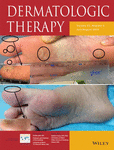Serpentine supravenous hyperpigmentation related to carboplatin and vinorelbine chemotherapy: A case report
Corresponding Author
Fatma Tuncez Akyurek
Faculty of Medicine, Department of Dermatology, Selcuk University, Konya, Turkey
Correspondence
Fatma Tuncez Akyurek, Faculty of Medicine, Department of Dermatology, Selcuk University, Konya, Turkey.
Email: [email protected]
Search for more papers by this authorNihal Sari
Faculty of Medicine, Department of Dermatology, Selcuk University, Konya, Turkey
Search for more papers by this authorCeyhan Ugurluoglu
Faculty of Medicine, Department of Pathology, Selcuk University, Konya, Turkey
Search for more papers by this authorGulcan Saylam Kurtipek
Faculty of Medicine, Department of Dermatology, Selcuk University, Konya, Turkey
Search for more papers by this authorCorresponding Author
Fatma Tuncez Akyurek
Faculty of Medicine, Department of Dermatology, Selcuk University, Konya, Turkey
Correspondence
Fatma Tuncez Akyurek, Faculty of Medicine, Department of Dermatology, Selcuk University, Konya, Turkey.
Email: [email protected]
Search for more papers by this authorNihal Sari
Faculty of Medicine, Department of Dermatology, Selcuk University, Konya, Turkey
Search for more papers by this authorCeyhan Ugurluoglu
Faculty of Medicine, Department of Pathology, Selcuk University, Konya, Turkey
Search for more papers by this authorGulcan Saylam Kurtipek
Faculty of Medicine, Department of Dermatology, Selcuk University, Konya, Turkey
Search for more papers by this authorAbstract
Serpentine supravenous hyperpigmentation (SSH) is a unique type of chemotherapy-associated drug eruption, characterized by hyperpigmentation along the superficial venous network. Histopathology reveals an increase in melanin production without destruction of basal cells of the epidermis or dermal inflammatory infiltrate. Herein, we describe a patient who developed SSH after repeated intravenous infusions with carboplatin and vinorelbine; two medications that have been uncommonly reported in association with SSH previously.
REFERENCES
- Aydogan, I. (2005). Persistent serpentine supravenous hyperpigmented eruption associated with docetaxel. Journal of the European Academy of Dermatology and Venereology, 19(3), 345–347.
- Cecchi, R. (1994). Supravenous hyperpigmentation induced by vinorelbine. Dermatology, 188(3), 244–244.
- Chan, C. C. (2010). Images in clinical medicine. Serpentine supravenous hyperpigmentation. New England Journal of Medicine, 363(5), e8.
- Chen, G. Y. (2005). Sclerotic and retracted supravenous hyperpigmentation associated with combination chemotherapy for metastatic breast carcinoma. The British Journal of Dermatology, 152(6), 1383–1385.
- Fine, J. D. (1986). Distinctive eruption characterized by linear supravenous papules and erythroderma following broxuridine (bromodeoxyuridine) therapy and radiotherapy. Archives of Dermatology, 122(2), 199–200.
- Geddes, E. R. (2010). Antineoplastic agent-associated serpentine supravenous hyperpigmentation: Superficial venous system hyperpigmentation following intravenous chemotherapy. Southern Medical Journal, 103(3), 231–235.
- Ghosh, S. K. (2011). Letter: Docetaxel-induced supravenous serpentine dermatitis. Dermatology Online Journal, 17(11), 16.
- Hrushesky, W. J. (1976). Serpentine supravenous fluorouracil hyperpigmentation. JAMA, 236(2), 138–138.
- Jain, V. (2005). Serpentine supravenous streaks induced by 5-fluorouracil. Journal of the American Academy of Dermatology, 53(3), 529–530.
- Jamalpur, I. (2017). Serpentine supravenous hyperpigmentation. Clinical Case Reports, 5(9), 1546–1547.
- Koehn, G. G. (1982). Unusual local cutaneous reaction to dacarbazine. Archives of Dermatology, 118(12), 1018–1019.
- Lang, K. (2002). Supravenous hyperpigmentation, transverse leuconychia and transverse melanonychia after chemotherapy for Hodgkin's disease. Journal of the European Academy of Dermatology and Venereology, 16(2), 162–163.
- Marcoux, D. (2000). Persistent serpentine supravenous hyperpigmented eruption as an adverse reaction to chemotherapy combining actinomycin and vincristine. Journal of the American Academy of Dermatology, 43(3), 540–546.
- Marongiu, P. (2009). Chemotherapy-induced persistent serpentine supra-venous hyperpigmented eruption and persistent supra-venous erythematous eruption: Case report. Giornale Italiano di Dermatologia e Venereologia: Organo Ufficiale, Societa Italiana di Dermatologia e Sifilografia, 144(1), 97–100.
- Payne, A. S. (2006). Dermatologic toxicity of chemotherapeutic agents. Seminars in Oncology, 33(1), 86–97.
- Rao, R. (2010). Serpentine supravenous pigmentation. A rare vasculocutaneous effect induced by systemic 5-fluorouracil. Indian Journal of Dermatology, Venereology and Leprology, 76(6), 714–715.
- Reyes-Habito, C. M. (2014). Cutaneous reactions to chemotherapeutic drugs and targeted therapies for cancer: Part I. conventional chemotherapeutic drugs. Journal of the American Academy of Dermatology, 71(2), 203–e1.
- Roach, E. C. (2015). Serpentine supravenous hyperpigmentation resulting from vinorelbine administration. The Breast Journal, 21(3), 311–312.
- Spencer, H. J. (1984). Local erythema multiforme-like drug reaction following intravenous mitomycin C and 5-fluorouracil. Journal of Surgical Oncology, 26(1), 47–50.
- Susser, W. S. (1999). Mucocutaneous reactions to chemotherapy. Journal of the American Academy of Dermatology, 40(3), 367–398.




